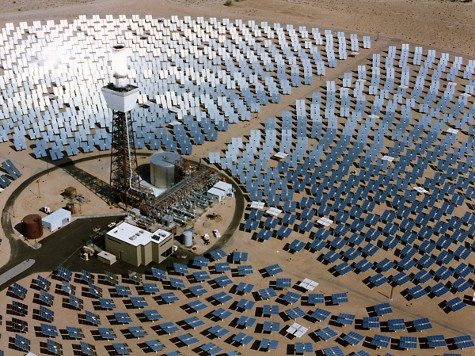California ranks third in the U.S., behind Hawaii and New Jersey, with 1.1% of statewide electrical power production being generated by customer-sited solar panels. The driving force behind this growth has been the 30% federal investment tax credit, plus incentives to meet Governor Jerry Brown’s California Renewables Portfolio Standard, which mandates 33% of electrical power be generated from intermittent solar and other green energy sources by 2020.
However, a new federally-funded report warns that California could be headed for another electric utility crisis, like the one in 2003 that caused Governor Gray Davis to be recalled.
California solar power generation rose by 900% over the last 30 months. Pacific Gas & Electric is ranked second in the nation with 2.3% of its electric power coming from customer-sited solar, and San Diego Gas & Electric is ranked third with 2.0%.
But the state of California’s social engineering of electrical power has a troubled history. The California Public Utilities Commission developed an electric deregulation plan that became the basis for Assembly Bill AB1890, which passed unanimously in 1996. Prior to the bill, public utilities received a “percent rate of return” gross profit of about 13% for the power generation they built. Yet academics and liberal constituencies complained that rate of return was an incentive to build too many power plants.
AB1890 required electric utilities to divest all of their power generating assets and replace “rate-of-return” reimbursement with a “competition transition charge,” equal to the net difference between the state price-controlled electric rates and the price a state-operated exchange could purchase on the supposedly cheaper commodity market.
But commodity electrical prices skyrocketed up in price between 2001 and 2002. Rather than approving a huge retail electricity price hike that might upset voters before his 2002 reelection, Democrat Governor Gray Davis kept rates at their fixed cost. PG&E was subsequently forced to declare bankruptcy, and Davis was recalled (to be replaced by Republican Arnold Schwarzenegger) a year later.
The normally liberal Brookings Institution recently found that the intermittency of solar power after construction, maintenance costs, and periods without sunshine makes solar only efficient as a source of energy 15% of the time. This compares to 25% for wind, and 90% for nuclear and natural gas generators.
Even when Brookings assigned a financial credit for reducing CO2, solar was still wildly more expensive than other energy sources.
A new federally-funded Lawrence Berkley National Laboratory study warns that as solar power grows as a percent of utilities power sources, public utility profitability may collapse. Due to the intermittency of solar power availability, utilities are required to pay huge stand-by rates for fossil fuel plants to be available to quickly come on line during any part of a day when the sun does not shine.
The National Lab estimates that at 2.5% solar penetration, a utility’s revenue would fall by 4%; at 10% penetration, revenue would slump by 8%; and at 15% penetration rate for customer-sited solar is reached, utilities’ revenue would fall by 15%.
In the 92 major utility cases last year, regulators only granted gas and electric utilities returns of 10%, according to Regulatory Research Associates. Without the California Public Utility Commission, whose members are appointed by the governor, granting a huge increase in rate of return, California utilities run the risk of generating increasing cash deficits.
The last time a California utility ran a 5% cash deficit was PG&E in 2002. Unable to get approval for huge retail rate increases, PG&E filed for bankruptcy.
“Utilities fear a future in which more and more customers generate their own power, leaving others to shoulder the costs of paying for the electrical grid,” according to the San Francisco Chronicle. “The scenario even has a name, the “utility death spiral.”
Brown is pounding on his commitment to sustainable energy in an apparent stealth campaign for the Democrat nomination for President. But with his policies potentially causing another electric utility crisis, Brown may face the same type of challenges that led to former Governor Gray Davis’s defeat.
Chriss Street suggests that if you are interested in California’s economy, please click on “California’s 15 Cent Gasoline Surtax Seems Unstoppable“

COMMENTS
Please let us know if you're having issues with commenting.